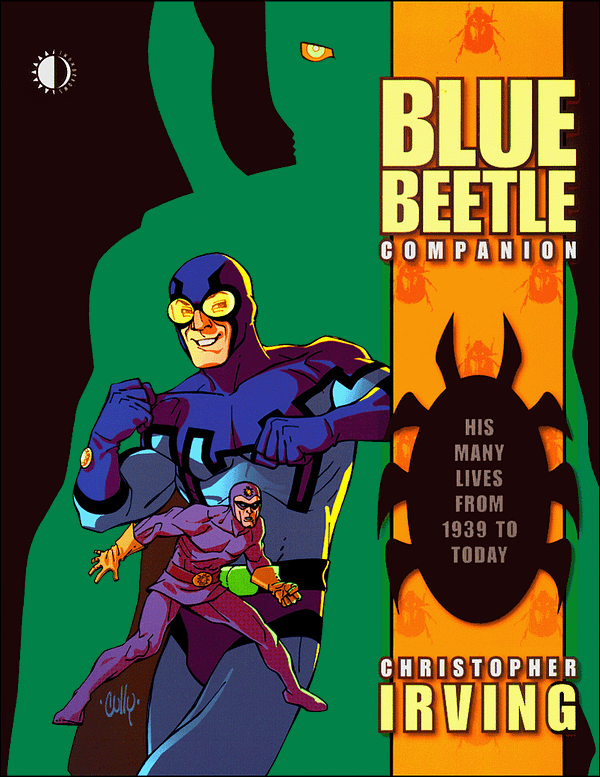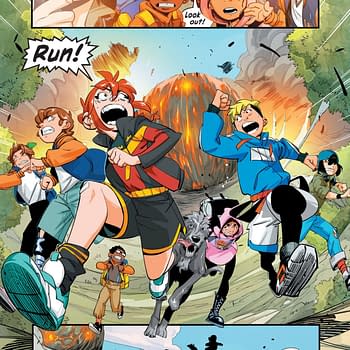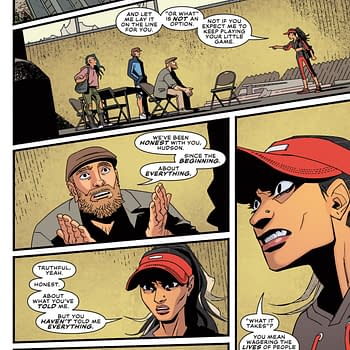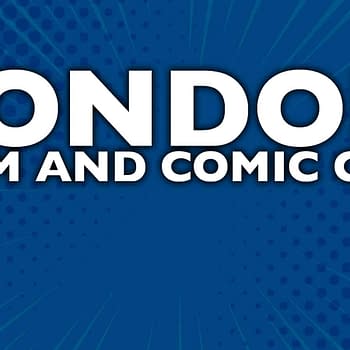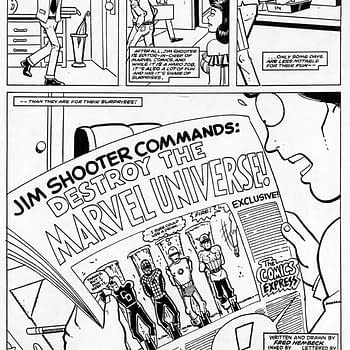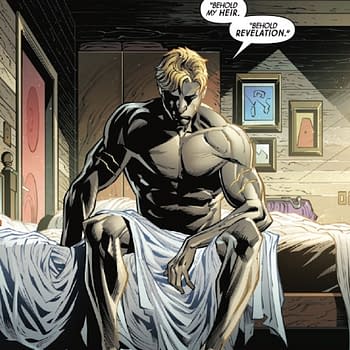Posted in: Comics, Recent Updates | Tagged: Christopher Irving, Comics, comics history, cully hamner, entertainment, steve ditko, The Blue Beetle Companion: His Many Lives From 1939 To Today, Tom Feister, TwoMorrows
The Blue Beetle Companion: His Many Lives From 1939 To Today Arrives In E-book Format
By Christopher Irving
After selling out its print run, the only comprehensive comics history book on The Blue Beetle returns in a full-color version with slight updates.
"One punch!"
That was my introduction to Blue Beetle, as Ted Kord's index finger probed under a yellow goggle to wipe a tear brought on from laughing so hard he cried.
I was probably eleven or twelve, and decided then and there that I liked this guy. Blue Beetle had enough of an everyman about him to make him a superhero you'd want to hang out with.
It was the early '90s, before the Internet, and before comics history could be found anywhere beyond a handful of books and Comics Buyers' Guide (the newspaper for comics news, editorials, and previews; it arrived every week in my mailbox. It would later become one of the first magazines I worked for). This Blue Beetle, reproduced in black and white, bore a domino mask and a scaly tunic—not the striking duo tone costume of the guy who hung out with the Justice League. Blue Beetle also warranted mention in Jules Feiffer's The Great Comic Book Heroes, the first major book on old comic books, given to me by my father (it now has a place of honor on my bookshelf, marked up with autographs from several great Golden Age creators, now sadly no longer with us).
The Blue Beetle became my comics history windmill to chase, and chase it I did, through college in the mid to late '90s. When I broke into the magazines in 2000, as comics news sites and blogs were taking hold (but before print started to die), The Blue Beetle became the subject of my cover story for Comic Book Marketplace.
This is the long and short of the Golden Age version, and why he's so incredibly important: He is one of the first trans-media superheroes, following Superman in shameful imitation with a comic strip (written and drawn by a young Jack Kirby under the pen name "Charles Nicholas") and radio show (which originally starred radio and film character actor Frank Lovejoy). Several comics legends like Will Eisner, Joe Simon, Lou Fine, Jack Kirby, and Matt Baker drew his adventures. The original Blue Beetle is also the only superhero to reflect the popular trends in superhero comics, as he constantly metamorphosed into a patriotic hero, a superman, or a street level crimefighter—all depending on what was big at the time.

Kord flitted around after the demise of Charlton's comic book line in the '70s; he briefly appeared at AC Comics (the publishers of FemForce, who are still at it today), and then found his new home at DC Comics in the mid-'80s.
Then, in 2004, Ted Kord was killed off in Countdown to Infinite Crisis. Never before have I heard so much fan outrage from a loyal and devout fanbase. Part of me was amongst that choir, but I've always chased it down with a shot of reality: he's a comic book character (and a superhero at that), published by a company that changes its continuity almost as much as some of us change apartments.
The Blue Beetle's publishing history made him my first book pitch to TwoMorrows Publishing, back in '05. My pitch to publisher John Morrow went as such: "He's a vital character to comics history, and if we're ever gonna sell it, now's the time."
I give John Morrow an immense amount of credit: he knew going in that The Blue Beetle Companion: His Many Lives from 1939 to Today would be a risk. When I opted to make it an essay book rather than a collection of Q and A interviews (the usual TwoMorrows model at the time), he backed me up on that, as well. This slim volume would be a research book that first and foremost would put the character's history into the big picture of the superhero genre's own, and would be populated by all the oddball and amazing (often genius) people who contributed to his development.
In my journey of trying to learn the character's significance, I learned why so many of us love Ted Kord so much and why he works.
I credit the Justice League of the '80s for keeping Kord from obscurity. The cancellation of the post-Crisis Blue Beetle comic could have placed him in superhero limbo. Giffen, DeMatteis, and Maguire gave Ted Kord a sense of humor and personality that insured his continued life.
While the Dan Garrett versions are the weaker characters, they're important in the grand scheme of comics history. The Golden Age version was a mimic of the popular superhero trends. The Silver Age Dan Garret was the first superhero revival, and preceded the Barry Allen Flash by about two years.
Ted Kord was the first superhero Steve Ditko started applying his philosophy through. Read those Charlton Ditko issues, done around the same time as his run on The Question: they're amazing, as is Objectivism's gradual presence in the work. The Art Destroyer issue immediately comes to mind.
Chuck Dixon had a brilliant idea. He was going to have Tim Drake become Blue Beetle for a new mini-series that featured Ted Kord working behind-the-scenes ala Oracle (Ted had just had a heart attack in Birds of Prey). Before DC changed Tim to make him more like Batman, he was a lot more like Ted personality-wise.
Ted Kord was a smart character to kill off. I know many fans will throw sharp objects at me for saying that, but it's true. We loved him so strongly and so much that his death was that much more resonant and impactful because of it. I hated that he got his brains blown out, but he at least went out like a total badass.
But let's be honest: it's a superhero death in a comic book and really hard to take too much stock in its permanence.
Jaime Reyes had the best Blue Beetle ongoing series to date. John Rogers, Keith Giffen, and Cully Hamner (then Rafael Albuquerque) crafted a brilliant hero's journey for Reyes, made more effective to characters and fans via the legacy aspect of the Blue Beetle. Jaime is arguably a more marketable character than Ted, as his success in cartoons like Young Justice and Brave and the Bold show. I think DC's removing Ted Kord from the character's origin via the New 52 was a mistake and took much of the scariness and tragedy out of his origins.
Now is the time to bring Ted Kord back. Thank God for Justice League 3000: we've at least got him and Booster back in the hands of the creators who made them so damn loveable in the first place. Outside of comics, we all know that Ray Palmer on Arrow was originally meant to be Ted Kord (and he really is, for all intents and purposes), but Warner apparently has live action plans for him. Let's hope they do him as right as Arrow has.
And, finally, The Blue Beetle Companion is the book I get asked about more than any other. Even Leaping Tall Buildings, which I worked on with Seth Kushner for about four years, gets fewer questions. A guy who works at a comic shop in the Village referred to it as his bible and has a Ted Kord tattoo. My first email back from Batman producer Michael Uslan about interviewing him mentioned how much he loved reading it. Bill Murphy, who I just wrapped up the latest Amazing Heroes Kickstarter with, knew me from it. I even became acquainted with the nephew of Charles Nicholas, who created the character via Eisner and Iger's studio. I got an email from a French historian just last month about the Blue Beetle comic strip.
Almost ten years later, it is still one of the projects I'm most proud of, from the front cover by Cully Hamner to the back one by Tom Feister. Since the print run is now sold out, I'm happy that TwoMorrows is making an ebook of it.
Seeing it in full color for the first time is breathtaking, and I'm gearing up to print out a hard copy for my own archives.
THE BLUE BEETLE COMPANION: HIS MANY LIVES FROM 1939 TO TODAY by Christopher Irving, includes Cully Hamner, Tom Feister, Steve Ditko, Will Eisner, Lou Fine, Dick Giordano, John Rogers, Keith Giffen, JM DeMatteis, and Kevin Maguire. It was published in 2006, and now in ebook format in 2015.
The Blue Beetle Companion can be bought today from the TwoMorrows website for $5.95. It will soon be available via the TwoMorrows app for both Android and IOS for $7.99.
Christopher Irving a comic book historian in Richmond, VA. His prior work has been as writer (with photographs by Seth Kushner) of Leaping Tall Buildings: The Origins of American Comics and the accompanying Graphic NYC web project; Comics Introspective: Peter Bagge; and Graphic NYC Presents: Dean Haspiel, the Early Years. He is currently working as copywriter/scriptwriter for Fresh Monkey Fiction's upcoming line of Amazing Heroes superhero action figures.


